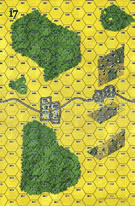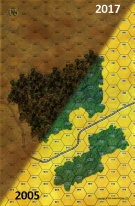Sinister Rails
White Eagles #32
|
|
(Attacker)
Poland
|
vs |
Germany
(Defender)
|
|
|
|
Total |
| Side 1 |
0 |
| Draw |
0 |
| Side 2 |
2 |
|
Total |
| Side 1 |
0 |
| Draw |
0 |
| Side 2 |
2 |
|
Total |
| Side 1 |
0 |
| Draw |
0 |
| Side 2 |
0 |
|
| Overall Rating, 2 votes |
|---|
|
|
|
Scenario Rank:
--- of 940 |
| Parent Game |
White Eagles |
| Historicity |
Historical |
| Date |
1939-09-02 |
| Start Time |
07:00 |
| Turn Count |
24 |
| Visibility |
Day |
| Counters |
46 |
| Net Morale |
0 |
| Net Initiative |
2 |
| Maps |
2: 17, 6 |
| Layout Dimensions |
56 x 43 cm
22 x 17 in |
| Play Bounty |
131 |
| AAR Bounty |
227 |
| Total Plays |
2 |
| Total AARs |
0 |
|
Introduction
|
|
At most places where the Germans attacked the Poles, the Polish and German infantry found themselves evenly matched in terms of training, morale and small-unit leadership. But the Germans had enormous advantages in artillery, air support, massed armor and overall numbers. On the rare occasion when the Poles thought they could overcome these, they struck back with counter-attacks of their own. One such opportunity came at Tychy, south of Katowice, where the 23rd Infantry Division had the support of armored train Number 54 "Grozny" ("Sinister") and its full allotment of rail-capable tanks and assault troops.
|
|
Conclusion
|
|
The train's assault platoon suffered heavy casualties from enemy machine gun and mortar fire, but the assault itself was considered quite successful as the Germans were driven back from their forest positions around Tychy. The train's commander, Capt. Jan Rybczinski, was killed while commanding one of its rail-equipped tankettes, however, and Army command ordered the train to move into a reserve position out of the front lines.
|
Display Relevant AFV Rules
| AFV Rules Pertaining to this Scenario's Order of Battle |
- Vulnerable to results on the Assault Combat Chart (7.25, 7.63, ACC), and may be attacked by Anti-Tank fire (11.2, DFT). Anti-Tank fire only affects the individual unit fired upon (7.62, 11.0).
- AFV's are activated by tank leaders (3.2, 3.3, 5.42, 6.8).
They may also be activated as part of an initial activating stack, but if activated in this way would need a tank
leader in order to carry out combat movement.
- AFV's do not block Direct Fire (10.1).
- Full-strength AFV's with "armor efficiency" may make two anti-tank (AT) fire attacks per turn
(either in their action segment or during opportunity fire) if they have AT fire values of 0 or more
(11.2).
- Each unit with an AT fire value of 2 or more may fire at targets at a distance of between 100% and 150% of its
printed AT range. It does so at half its AT fire value. (11.3)
- Efficient and non-efficient AFV's may conduct two opportunity fires per turn if using direct fire
(7.44, 7.64).
Units with both Direct and AT Fire values may use either type of fire in the same turn as their opportunity fire,
but not both (7.22, 13.0).
Units which can take opportunity fire twice per turn do not have to target the same unit both times (13.0).
- Demoralized AFV's are not required to flee from units that do not have AT fire values (14.3).
- Place a Wreck marker when an AFV is eliminated in a bridge or town hex (16.3).
- AFV's do not benefit from Entrenchments (16.42).
- AFV's may Dig In (16.2).
- Closed-top AFV's: Immune to M, M1 and M2 results on Direct and Bombardment Fire Tables. Do not take step losses from Direct or Bombardment Fire. If X or #X result on Fire Table, make M morale check instead (7.25, 7.41, 7.61, BT, DFT).
- Closed-top AFV's: Provide the +1 modifier on the Assault Table when combined with infantry. (Modifier only applies to Germans in all scenarios; Soviet Guards in scenarios taking place after 1942; Polish, US and Commonwealth in scenarios taking place after 1943.) (ACC)
- Tank: all are closed-top and provide the +1 Assault bonus, when applicable
|
| 2 Errata Items |

|
The reduced direct fire value of the Heer HMG became 5-5 starting with Fall of France.
|

|
The movement allowance on the counters in Airborne is misprinted. It should be "3."
|







 WhEa031
WhEa031 




















